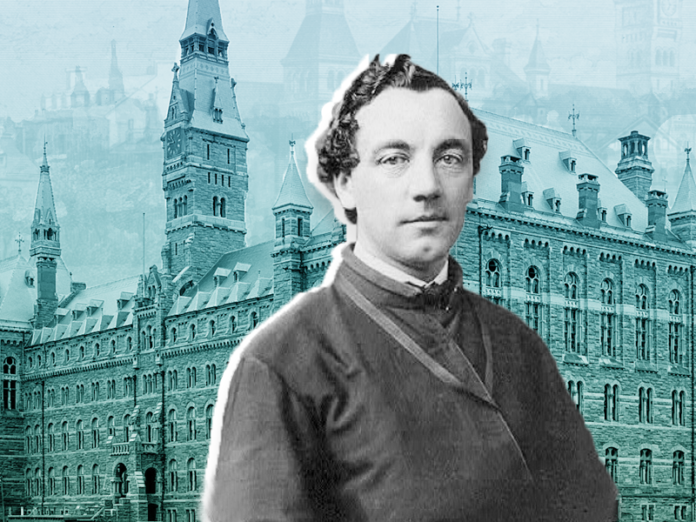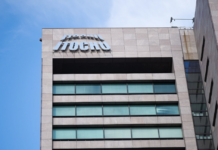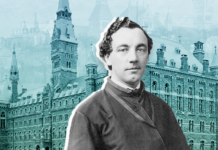![]()
Disclaimer: The views and opinions expressed in this article are those of the author(s) and do not necessarily reflect the official or personal position of the Editorial Board, Contributors, or Business Staff of The Georgetown Review.
Many students soon to decide what college they should go to will be right to scratch Georgetown off of their list. Georgetown University has decided to remove from its historic Philodemic Hall walls the paintings and photographs of men who served as Confederate soldiers and statesmen or simply hailed from the South. The question now is, can their descendants feel welcomed? Georgetown took the lead from its Philodemic Society, founded in 1830. If that describes you, you may feel unwelcome in the Philodemic as well, coming in stark violation of the University’s student activities code.
It is not the first time the University has been led by the Philodemic Society. In the past it was for the better. Philodemic alumni worked hard after the Civil War to retire the crippling debt from the construction of massive Healy Hall. They founded the University’s alumni association, as well as its Board of Regents, and even endowed their own Philodemic Hall. In 1949, the campus still flush with GI Bill veterans, Georgetown students rallied from the Philodemic President’s chair to deploy their historic tactic against ham-fisted administrators – a campus-wide student walk out. This time it was not over the bad food. It was to demand that the Jesuits desegregate the College. The Jesuits finally relented in 1950.
This time, however, the Philodemic and the University administration, some transient named Dr. Ferrara to be exact, have jumped together into the shallow end, ending yet another tradition.
Maybe it was that they didn’t listen to their mothers when told not to defecate where you debate, or to confuse the two. Maybe that is where the students of the Philodemic Society, once the oldest collegiate debating society in the Western Hemisphere, went wrong. Of course, they are no longer a debating society. Debate was replaced by advocacy and the once great Society is now nothing more than an advocacy “club.” It has surrendered to the racialization-of-everything agenda that swept the country a few years ago. And maybe that, “a few years ago,” is another clue as to where the Philodemic went wrong.
In 2018, the Philodemic set up a slavery remembrance committee. The Committee researched the Hall’s portraits and determined that a very few oil portraits and antique photographs should be removed from the room mostly because they represented men who served the Confederacy. The offending few portraits included William Gaston, Georgetown’s first student, for whom the entirety of historic Gaston Hall is named, just up the stairs from Philodemic Hall. Ironically, Judge Gaston was an abolitionist. The canceled portraits also included Jesuit Fr. Doonan, one of the University’s greatest presidents. Although the priest had worn the Union blue, the rap on him, said the Philodemic students, was that he was from Atlanta and a “Southerner.” The Philodemicians described Felix Cipriano Colonel Zegarra as a Washington physician “born to a Maryland estate.” In fact, Zegarra was a Peruvian statesman, jurist, diplomat, historian and ambassador to the United States. It was shoddy work.
Never mind, of course, that all the portraits were in the Hall solely because they had been Georgetown students and Philodemicians. The Philodemic Committee made a written demand on the University President’s office – enter Dr. Ferrara. He swallowed it all.
Let’s focus on “In 2018.” Philodemic students pride themselves on their debate skills, agile minds, and reason. Yet most Philodemicians today have neither debated nor voted on the course that the University has taken most cynically and supposedly on their behalf. In 2018, the promoters of the racialize-everything agenda went so far as to amend the Philodemic bylaws to incorporate their agenda into it. The Philodemic stopped being a debate society. After 192 years, it now has an agenda. The amazing part is that most students today never voted on it. They are now pursuing an advocacy agenda decided for them by others. That may be where the Philodemic Society has gone wrong. They have abdicated decisions to others.
The Georgetown Review recently published a piece by Dr. Joseph J.F. Flahive, a beloved Philodemician and a world-renowned scholar. He points to another place where the Philodemic Society went wrong, including where Dr. Ferrara’s expensive “reimagination” has totally failed the truth, perhaps intentionally.
In a tentacled response to the Philodemic’s racialist but small request, Dr. Ferrara has launched an expensive reimagining of Philodemic Hall and has removed not a few, but all the Hall’s oils and time-capsule portraits. Dr. Ferrara’s hired-guns have studied the history of the molding, the plaster, and the curtains, using all the novel words of their trade. It is clear that they never researched the history or sought the truth about the Philodemic Society or its endowed Hall; a history that most all Philodemicians know to find in Fr. Joseph Durkin’s Swift Potomac’s Lovely Daughter. Durkin’s bicentennial effort, in fact, inspired the revival of the Philodemic Society in 1989. Its on-campus tradition had been defunct.
Philodemic Hall is a described interior room of a Historic Landmark Building, but, even more importantly, it has long stood as a living monument to the post-Civil War reconciliation initiatives of America’s first Black university president, Patrick Healy, S.J, who was born and remained a slave under the law of his home state for most of his life.
Philodemic Hall may well be the only monument in all the United States that remembers the post-bellum reconciliation that this country so desperately needed. Most of the photographs that Dr. Ferrara has ripped from the room, with significant plaster damage, were collected in a Philodemic alumni reunion called for by Fr. Healy. The invitation itself requested that returning Philodemicians bring a photograph to be placed within the Philodemic’s endowed new hall in the “New Building.”
Reconciliation must necessarily involve the victors and the vanquished, or it is not reconciliation. Understandably, Georgetown wishes to address the stain of the Jesuit ownership and 1838 sale of enslaved people. Rather than lead among its peers, Georgetown University has chosen to erase history and engulf Philodemic Hall into its hip slavery virtue-signaling narrative, entirely missing the historical and artistic value of the Hall they have begun to erase.
In doing so they are gas-lighting us to ignore the fact of Georgetown’s founder, John Carroll, owning slaves; his mother, for whom a dormitory is named, owning hundreds more; and many other slaveowners as well as the 1838 slave sellers currently buried in the Jesuit graveyard. It would make more of a point if they attempted to reimagine Carroll Parlor just down the stairs. Carroll owned slaves. The Philodemic Society did not.
Of course, the “reimagining” is all a cynical ploy to raise money and get the President’s office another utilitarian multi-purpose conference and reception room, indicating exactly what they have always wanted. The Philodemic’s youths are being bamboozled. Most ironically, however, Dr. Ferrara’s ham-fisted effort to “reimagine” Philodemic Hall erases one of the most profound legacies of Patrick Healy, S.J., born a slave.
John Agar served as President of the Philodemic Society and as the first President of the Yard in the 1870’s. He raised funds for the Healy Building’s debt and to endow Philodemic Hall. The author has adopted this as his pen name.
Do you share this sentiment? Sign on to a letter calling to end and reverse the reimagination of Philodemic Hall here.












